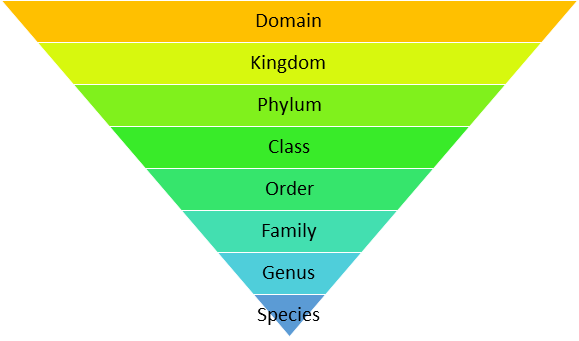
when we go from species to the kingdom in a taxonomic hierarchy, the number of common characteristics will?
(a)Will decrease
(b)Will increase
(c)Remain the same
(d)May increase or decrease
Answer
479.1k+ views
Hint: All living organisms are classified into different hierarchical levels depending on the common characteristics. The number of common characteristics is higher in the lowest taxonomic level common characteristics will be less in higher taxonomic levels.
Complete answer:
When we go from the lowest hierarchical level (species) to the highest hierarchical level ( kingdom) in a taxonomic hierarchy, the number of common characteristics will decrease. Let's take an example of the apple tree, scientific name- Malus Domestica, and the single-celled algae Chlamydomonas where both comes under the kingdom Plantae, but they do not have any common factors other than the similarity of have only one similarity that both produce chlorophyll and have a cell wall.
Additional Information: -Organisms with common characters are grouped or submerged into taxa and these groups are provided with a taxonomic rank.based on similar characteristics these groups are further segregated to create a different hierarchical level.
-Taxonomy is a sub-discipline of life-science which is usually practised by biologists called taxonomists. Taxonomists aim to define and classify life, also the classification directed by taxonomists is vital for the study of conservation of biodiversity
So, the correct answer is ‘Will decrease’
Note: -In history organisms were first categorized by Aristotle in Greece,383–321 BC where he classified organisms by their body organs and by other characters such as giving live birth, a number of legs, laying eggs, having blood, etc.
-Carl Linnaeus who is a Swedish botanist, is known as the "father of taxonomy". They revolutionized modern taxonomy With his major works such as “Systema Naturae”,” Species Plantarum” etc.
-The current taxonomic classification system has 8 major ranks which are Domain, Kingdom, Phylum, Class, Order, Family, Genus, and Species

Complete answer:
When we go from the lowest hierarchical level (species) to the highest hierarchical level ( kingdom) in a taxonomic hierarchy, the number of common characteristics will decrease. Let's take an example of the apple tree, scientific name- Malus Domestica, and the single-celled algae Chlamydomonas where both comes under the kingdom Plantae, but they do not have any common factors other than the similarity of have only one similarity that both produce chlorophyll and have a cell wall.
Additional Information: -Organisms with common characters are grouped or submerged into taxa and these groups are provided with a taxonomic rank.based on similar characteristics these groups are further segregated to create a different hierarchical level.
-Taxonomy is a sub-discipline of life-science which is usually practised by biologists called taxonomists. Taxonomists aim to define and classify life, also the classification directed by taxonomists is vital for the study of conservation of biodiversity
So, the correct answer is ‘Will decrease’
Note: -In history organisms were first categorized by Aristotle in Greece,383–321 BC where he classified organisms by their body organs and by other characters such as giving live birth, a number of legs, laying eggs, having blood, etc.
-Carl Linnaeus who is a Swedish botanist, is known as the "father of taxonomy". They revolutionized modern taxonomy With his major works such as “Systema Naturae”,” Species Plantarum” etc.
-The current taxonomic classification system has 8 major ranks which are Domain, Kingdom, Phylum, Class, Order, Family, Genus, and Species

Recently Updated Pages
How do you factor x2 + x 20 0 class 9 maths CBSE

How do you solve y6x and 2x+3y20 using substitutio class 9 maths CBSE

Chipko movement originated in Gopeshwar in A 1953 B class 9 biology CBSE

The adjacent sides in the parallelogram are supplementary class 9 maths CBSE

The compound used in plastic industry is A Vinyl acetate class 9 chemistry CBSE

How do you solve for y in 2left y dfrac12 right 4left class 9 maths CBSE

Trending doubts
According to Bernoullis equation the expression which class 11 physics CBSE

Draw a diagram of nephron and explain its structur class 11 biology CBSE

Differentiate between calcination and roasting class 11 chemistry CBSE

A solution of a substance X is used for white washing class 11 chemistry CBSE

What is spore formation class 11 biology CBSE

10 examples of friction in our daily life




